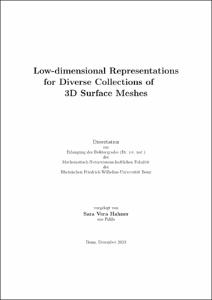Hahner, Sara Vera: Low-dimensional Representations for Diverse Collections of 3D Surface Meshes. - Bonn, 2024. - Dissertation, Rheinische Friedrich-Wilhelms-Universität Bonn.
Online-Ausgabe in bonndoc: https://nbn-resolving.org/urn:nbn:de:hbz:5-74559
Online-Ausgabe in bonndoc: https://nbn-resolving.org/urn:nbn:de:hbz:5-74559
@phdthesis{handle:20.500.11811/11369,
urn: https://nbn-resolving.org/urn:nbn:de:hbz:5-74559,
doi: https://doi.org/10.48565/bonndoc-241,
author = {{Sara Vera Hahner}},
title = {Low-dimensional Representations for Diverse Collections of 3D Surface Meshes},
school = {Rheinische Friedrich-Wilhelms-Universität Bonn},
year = 2024,
month = feb,
note = {The surfaces of 3D shapes are discretized by surface meshes that represent them in a processable way. This enables simulations of deforming components in CAE, animations for movies, or representations of human organs to plan operations. Since surface meshes are relevant in different areas, the amount of 3D surface meshes representing diverse shapes is constantly growing.
Since many datasets containing surface meshes are high-dimensional, we are interested in low-dimensional shape features that enable the analysis of the dataset structure. Nevertheless, reducing the redundancies while preserving the essential information is not trivial. We need to disentangle the features from the mesh representation to create global shape features invariant to the discretization by the mesh.
Many dimension reduction methods for surface meshes calculate spectral shape features. More recently, machine learning approaches have been applied to learn low-dimensional features for surface meshes. Nevertheless, the approaches depend on fixed surface mesh connectivity in the studied datasets. This limits not only the types of datasets that can be analyzed but also the transfer of learned methods and knowledge to different data.
To address these issues, I introduce two novel learning-based approaches for encoding 3D surface meshes in a low-dimensional space.
In the first approach, I transform the discretization of the surfaces to meshes with locally regular connectivity and hierarchical meshing. It allows me to divide the surfaces into patches, to which I then apply different convolutional methods for learning hierarchical features. The resulting Convolutional Semi-Regular Mesh Autoencoder (CoSMA) reconstructs surfaces not presented during training and generalizes the deformation behavior of the surface patches. In addition, I introduce a flexible optimization-based semi-regular remeshing algorithm that can handle a wide range of surface meshes and is tailored to the learning method.
In the second approach, I use correspondence maps between shapes to define a low-dimensional basis where all shapes are represented independently of their mesh representation. To this end, I propose a spectral mesh pooling technique that establishes this universal latent space, breaking free from the traditional constraints of mesh connectivity. The resulting network is called Canonical Consistent Latent Basis-Autoencoder (CCLB-AE).
In comparison to baselines, I can apply my networks to larger and more diverse datasets, whereas baselines handle only surface meshes with fixed mesh connectivity. The methods successfully learn shape features that reveal the structure of several datasets from different domains. Additionally, the reconstructions of the proposed methods are of higher quality than those of the baseline models. Moreover, the smooth embedding space allows for the generation of shapes by combining the learned low-dimensional shape representations. I conduct further experiments to evaluate the patch-based approach to learning hierarchical features for other tasks and predict time series in the joint CCLB-autoencoder embedding space.},
url = {https://hdl.handle.net/20.500.11811/11369}
}
urn: https://nbn-resolving.org/urn:nbn:de:hbz:5-74559,
doi: https://doi.org/10.48565/bonndoc-241,
author = {{Sara Vera Hahner}},
title = {Low-dimensional Representations for Diverse Collections of 3D Surface Meshes},
school = {Rheinische Friedrich-Wilhelms-Universität Bonn},
year = 2024,
month = feb,
note = {The surfaces of 3D shapes are discretized by surface meshes that represent them in a processable way. This enables simulations of deforming components in CAE, animations for movies, or representations of human organs to plan operations. Since surface meshes are relevant in different areas, the amount of 3D surface meshes representing diverse shapes is constantly growing.
Since many datasets containing surface meshes are high-dimensional, we are interested in low-dimensional shape features that enable the analysis of the dataset structure. Nevertheless, reducing the redundancies while preserving the essential information is not trivial. We need to disentangle the features from the mesh representation to create global shape features invariant to the discretization by the mesh.
Many dimension reduction methods for surface meshes calculate spectral shape features. More recently, machine learning approaches have been applied to learn low-dimensional features for surface meshes. Nevertheless, the approaches depend on fixed surface mesh connectivity in the studied datasets. This limits not only the types of datasets that can be analyzed but also the transfer of learned methods and knowledge to different data.
To address these issues, I introduce two novel learning-based approaches for encoding 3D surface meshes in a low-dimensional space.
In the first approach, I transform the discretization of the surfaces to meshes with locally regular connectivity and hierarchical meshing. It allows me to divide the surfaces into patches, to which I then apply different convolutional methods for learning hierarchical features. The resulting Convolutional Semi-Regular Mesh Autoencoder (CoSMA) reconstructs surfaces not presented during training and generalizes the deformation behavior of the surface patches. In addition, I introduce a flexible optimization-based semi-regular remeshing algorithm that can handle a wide range of surface meshes and is tailored to the learning method.
In the second approach, I use correspondence maps between shapes to define a low-dimensional basis where all shapes are represented independently of their mesh representation. To this end, I propose a spectral mesh pooling technique that establishes this universal latent space, breaking free from the traditional constraints of mesh connectivity. The resulting network is called Canonical Consistent Latent Basis-Autoencoder (CCLB-AE).
In comparison to baselines, I can apply my networks to larger and more diverse datasets, whereas baselines handle only surface meshes with fixed mesh connectivity. The methods successfully learn shape features that reveal the structure of several datasets from different domains. Additionally, the reconstructions of the proposed methods are of higher quality than those of the baseline models. Moreover, the smooth embedding space allows for the generation of shapes by combining the learned low-dimensional shape representations. I conduct further experiments to evaluate the patch-based approach to learning hierarchical features for other tasks and predict time series in the joint CCLB-autoencoder embedding space.},
url = {https://hdl.handle.net/20.500.11811/11369}
}






